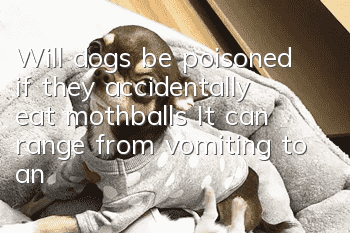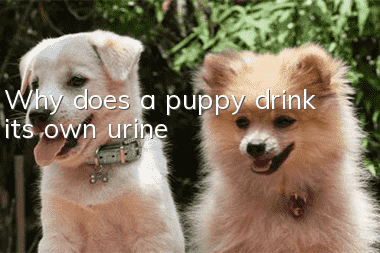Will dogs be poisoned if they accidentally eat mothballs? It can range from vomiting to anemia or liver and kidney damage.

I believe everyone knows that moth balls can prevent insects, moths, and mildew, so we often put them in the wardrobe. But if your dog likes to rummage through boxes and cabinets, the owner should be careful about the dog eating mothballs. There are two types of mothballs on the market. One is natural mothballs, which have a relatively refreshing smell, while the other is synthetic mothballs, which have a pungent and unpleasant smell and are harmful to dogs and people. Once a dog eats synthetic mothballs, it will often show symptoms of poisoning. Sometimes even smelling the smell may cause damage to the body.
1. Why are mothballs harmful to dogs? Because of the two harmful ingredients naphthalene and p-dichlorobenzene
Natural mothballs are aromatic organic compounds extracted from camphor branches and leaves, while synthetic mothballs are mainly composed of naphthalene or p-dichlorobenzene. Since the cost of making synthetic mothballs is relatively low and natural camphor resources are limited, synthetic mothballs are Mothballs once replaced natural mothballs. Both naphthalene and paradichlorobenzene can cause poisoning in dogs, but paradichlorobenzene is about half as toxic as naphthalene.
Data shows that dogs are generally poisoned after eating mothballs, but naphthalene can also be absorbed into dogs through the skin and air. It will not only affect the dog’s gastrointestinal system, but also destroy the dog’s red blood cells, causing anemia. . After paradichlorobenzene enters the body of dogs, nervous system dysfunction often occurs, and in a few cases, red blood cells are destroyed.
2. The effects of mothball poisoning on dogs can lead to anemia in severe cases
If the dog eats paradichlorobenzene mothballs, although it is less toxic, it can also cause vomiting, loss of appetite and other symptoms, and cause neurological dysfunction, confusion, convulsions, difficulty walking, drooling, Symptoms such as epileptic seizures. When your dog's skin comes into contact with paradichlorobenzene, it may feel like it's being burned. The fumes produced by naphthalene and paradichlorobenzene can irritate the dog's nose, eyes and lungs, causing the dog's eyes to become red, runny nose, sneezing and coughing.
If a dog eats naphthalene mothballs, it will first damage the gastrointestinal system and cause symptoms such as vomiting and loss of appetite. Later, naphthalene will also damage the dog's red blood cells, causing symptoms such as weakness, lethargy, blue gums, and difficulty breathing. In severe cases, it can also cause liver damage or cataracts.
If the packaging bag of mothballs is lost, the owner can use this method to test whether it is natural:
1. Prepare half a cup of warm water
2. Add 3-4 tablespoons of salt to the water
3. Add some salt as appropriate and stir while adding until the salt is no longer dissolved
4. Put the moth balls into the salt water
5.NaturalMothballs will float, while synthetic mothballs will sink
3. How to diagnose mothball poisoning in dogs? Smell the gas exhaled by the dog
Because mothballs dissolve very slowly in dogs, owners may not notice symptoms of poisoning in dogs until a few days later. Once you suspect that your dog has eaten mothballs, the owner can first smell the air it exhales, which will usually smell like mothballs. It is best for the owner to take it to the pet hospital for examination, but remember to bring the mothball packaging bag so that the doctor can know what kind of mothball the dog has eaten.
4. How to treat camphor ball poisoning in dogs? In mild cases, it can induce vomiting and take medicine, or in severe cases, oxygen and blood transfusion
The pet doctor will first evaluate the dog's poisoning situation. Since mothballs dissolve slowly, the dog will vomit non-stop within the first 2 hours. At this time, the doctor will consider inducing vomiting to expel undigested mothballs. The dog will then undergo blood tests and X-rays to check for anemia or liver damage, as well as the presence of mothballs in the stomach and intestines. If necessary, the dog needs intravenous fluids, which can protect the kidneys and eliminate toxins to a certain extent.
If your dog has severe convulsions or epilepsy symptoms, you need to take medication to relieve it, while also reducing stomach irritation and reducing gastric acid production. Since naphthalene can damage red blood cells, causing a lack of oxygen in the blood, dogs also need oxygen. In severe cases, the dog's tooth mucosa and blood will turn brown. This is caused by a type of methemoglobinemia, but it can be solved with drugs such as ascorbic acid, methylene blue or N-acetylcysteine, if necessary. Blood transfusions were also required.
If the owner takes the dog to the pet hospital in time and the poisoning is mild, the dog will recover quickly after proper treatment. But if the dog develops anemia or liver and kidney damage, the situation will be more serious and the dog will need to be hospitalized. So it’s best not to buy synthetic mothballs, they only cost a few dollars and are not good for people.
Reference: Desnoyers M, Hébert P. Heinz body anemia in a dog following possible naphthalene ingestion[J]. Veterinary clinical pathology, 1995, 24(4): 124-125.
- Dog suddenly urinates frequently
- How to make a dog jump on the sofa and what kind of training is needed?
- Benefits of dog vaccinations
- How to train a dog to stand for punishment
- How full is better for a dog to eat?
- What can you do if your dog snores?
- The origin of the Saint Bernard dog
- Can dogs chew sheep bones?
- Boston Terrier Habits
- The dog's leg suddenly became lame



